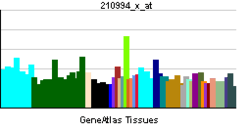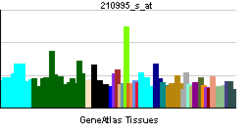TRIM23
| Tripartite motif containing 23 | |||||||||||||
|---|---|---|---|---|---|---|---|---|---|---|---|---|---|
| Identifiers | |||||||||||||
| Symbols | TRIM23 ; ARD1; ARFD1; RNF46 | ||||||||||||
| External IDs | OMIM: 601747 MGI: 1933161 HomoloGene: 1251 GeneCards: TRIM23 Gene | ||||||||||||
| |||||||||||||
| RNA expression pattern | |||||||||||||
 | |||||||||||||
 | |||||||||||||
 | |||||||||||||
| More reference expression data | |||||||||||||
| Orthologs | |||||||||||||
| Species | Human | Mouse | |||||||||||
| Entrez | 373 | 81003 | |||||||||||
| Ensembl | ENSG00000113595 | ENSMUSG00000021712 | |||||||||||
| UniProt | P36406 | Q8BGX0 | |||||||||||
| RefSeq (mRNA) | NM_001656 | NM_030731 | |||||||||||
| RefSeq (protein) | NP_001647 | NP_109656 | |||||||||||
| Location (UCSC) | Chr 5: 64.89 – 64.92 Mb | Chr 13: 104.18 – 104.2 Mb | |||||||||||
| PubMed search | |||||||||||||
GTP-binding protein ARD-1 is a protein that in humans is encoded by the TRIM23 gene.[1][2]
The protein encoded by this gene is a member of the tripartite motif (TRIM) family. The TRIM motif includes three zinc-binding domains, a RING, a B-box type 1 and a B-box type 2, and a coiled-coil region. This protein is also a member of the ADP ribosylation factor family of guanine nucleotide-binding family of proteins. Its carboxy terminus contains an ADP-ribosylation factor domain and a guanine nucleotide binding site, while the amino terminus contains a GTPase activating protein domain which acts on the guanine nucleotide binding site. The protein localizes to lysosomes and the Golgi apparatus. It plays a role in the formation of intracellular transport vesicles, their movement from one compartment to another, and phospholipase D activation. Three alternatively spliced transcript variants for this gene have been described.[2]
Interactions
TRIM23 has been shown to interact with TRIM31,[3] TRIM29[3] and PSCD1.[4]
References
- ↑ Mishima K, Tsuchiya M, Nightingale MS, Moss J, Vaughan M (May 1993). "ARD 1, a 64-kDa guanine nucleotide-binding protein with a carboxyl-terminal ADP-ribosylation factor domain". J Biol Chem 268 (12): 8801–7. PMID 8473324.
- ↑ 2.0 2.1 "Entrez Gene: TRIM23 tripartite motif-containing 23".
- ↑ 3.0 3.1 Reymond, A; Meroni G, Fantozzi A, Merla G, Cairo S, Luzi L, Riganelli D, Zanaria E, Messali S, Cainarca S, Guffanti A, Minucci S, Pelicci P G, Ballabio A (May 2001). "The tripartite motif family identifies cell compartments". EMBO J. (England) 20 (9): 2140–51. doi:10.1093/emboj/20.9.2140. ISSN 0261-4189. PMC 125245. PMID 11331580.
- ↑ Vitale, N; Pacheco-Rodriguez G; Ferrans V J; Riemenschneider W; Moss J; Vaughan M (July 2000). "Specific functional interaction of human cytohesin-1 and ADP-ribosylation factor domain protein (ARD1)". J. Biol. Chem. (UNITED STATES) 275 (28): 21331–9. doi:10.1074/jbc.M909642199. ISSN 0021-9258. PMID 10748148.
Further reading
- Vitale N, Moss J, Vaughan M (1996). "ARD1, a 64-kDa bifunctional protein containing an 18-kDa GTP-binding ADP-ribosylation factor domain and a 46-kDa GTPase-activating domain". Proc. Natl. Acad. Sci. U.S.A. 93 (5): 1941–4. doi:10.1073/pnas.93.5.1941. PMC 39887. PMID 8700863.
- Vitale N, Moss J, Vaughan M (1997). "Characterization of a GDP dissociation inhibitory region of ADP-ribosylation factor domain protein ARD1". J. Biol. Chem. 272 (40): 25077–82. doi:10.1074/jbc.272.40.25077. PMID 9312116.
- Vitale N, Moss J, Vaughan M (1998). "Molecular characterization of the GTPase-activating domain of ADP-ribosylation factor domain protein 1 (ARD1)". J. Biol. Chem. 273 (5): 2553–60. doi:10.1074/jbc.273.5.2553. PMID 9446556.
- Vitale N, Horiba K, Ferrans VJ et al. (1998). "Localization of ADP-ribosylation factor domain protein 1 (ARD1) in lysosomes and Golgi apparatus". Proc. Natl. Acad. Sci. U.S.A. 95 (15): 8613–8. doi:10.1073/pnas.95.15.8613. PMC 21124. PMID 9671726.
- Vitale N, Pacheco-Rodriguez G, Ferrans VJ et al. (2000). "Specific functional interaction of human cytohesin-1 and ADP-ribosylation factor domain protein (ARD1)". J. Biol. Chem. 275 (28): 21331–9. doi:10.1074/jbc.M909642199. PMID 10748148.
- Vitale N, Ferrans VJ, Moss J, Vaughan M (2000). "Identification of Lysosomal and Golgi Localization Signals in GAP and ARF Domains of ARF Domain Protein 1". Mol. Cell. Biol. 20 (19): 7342–52. doi:10.1128/MCB.20.19.7342-7352.2000. PMC 86288. PMID 10982851.
- Reymond A, Meroni G, Fantozzi A et al. (2001). "The tripartite motif family identifies cell compartments". EMBO J. 20 (9): 2140–51. doi:10.1093/emboj/20.9.2140. PMC 125245. PMID 11331580.
- Strausberg RL, Feingold EA, Grouse LH et al. (2003). "Generation and initial analysis of more than 15,000 full-length human and mouse cDNA sequences". Proc. Natl. Acad. Sci. U.S.A. 99 (26): 16899–903. doi:10.1073/pnas.242603899. PMC 139241. PMID 12477932.
- Gerhard DS, Wagner L, Feingold EA et al. (2004). "The Status, Quality, and Expansion of the NIH Full-Length cDNA Project: The Mammalian Gene Collection (MGC)". Genome Res. 14 (10B): 2121–7. doi:10.1101/gr.2596504. PMC 528928. PMID 15489334.
- Vichi A, Payne DM, Pacheco-Rodriguez G et al. (2005). "E3 ubiquitin ligase activity of the trifunctional ARD1 (ADP-ribosylation factor domain protein 1)". Proc. Natl. Acad. Sci. U.S.A. 102 (6): 1945–50. doi:10.1073/pnas.0409800102. PMC 548593. PMID 15684077.
- Rual JF, Venkatesan K, Hao T et al. (2005). "Towards a proteome-scale map of the human protein-protein interaction network". Nature 437 (7062): 1173–8. doi:10.1038/nature04209. PMID 16189514.